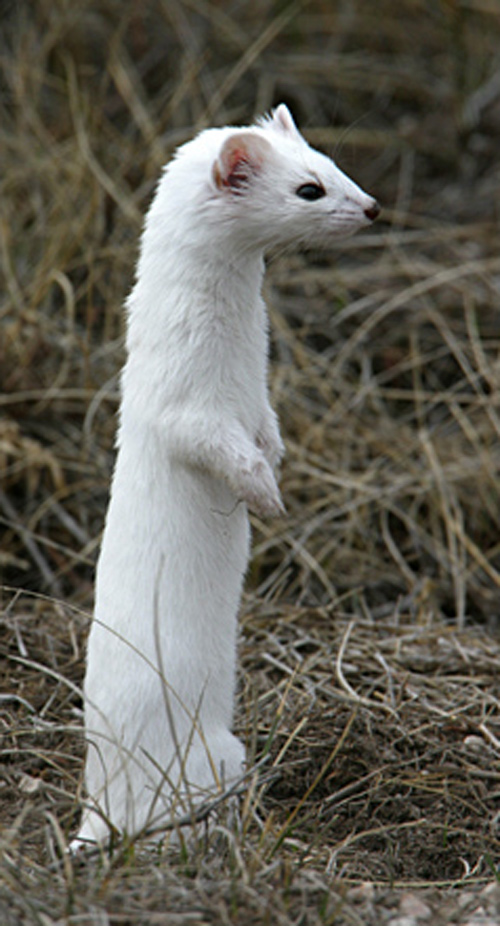Below the Knife River Villages in present North Dakota, construction continues. The captains obtain a white weasel pelt, and Clark describes how Mandan People feed and care for their horses.
How the Mandan Live
by Yellowstone Public Radio[1]Originally aired weekdays by Yellowstone Public Radio during the Bicentennial observance of 2003-2006. Narrated by Hal Hansen. Scripts by Whit Hansen and Ed Jacobson. Produced by Leni Holliman. © … Continue reading
Work Continues
a hard white frost last night. a clear & pleasant morning. we continued building as usal. we expect our hunters Soon as we are in Great want of fresh meat.—
—John Ordway
A Long-tailed Weasel
we got a White weasel, (Taile excepted which was black at the end) of an Indian
—William Clark
Fort Mandan Pastures
we are Situated in a point of the Missouri North Side in a Cotton wood Timber, this Timber is tall and heavy Containing an imence quantity of water Brickle [meaning brittle] & Soft food for Horses to winter (as is Said by the Indians)
—William Clark
Feeding Horses
The Mandans Graze their horses in the day on Grass, and at night give them a Stick of Cotton wood to eate, Horses Dogs & people all pass the night in the Same Lodge or round House, Covd. with earth with a fire in the middle
—William Clark
Ethnologist Gilbert Wilson provides more detail about sheltering and feeding horses during the winter:
We fed our more valuable lodge-kept horses the bark, tops, and small branches of cottonwood trees. Such fodder we fed them every night when we could get it . . . .
On pleasant days the women of the household went out every after-noon about two o’clock for bark. They commonly cut down two or three small trees, of perhaps a foot in diameter. They cut the rough, outer bark from the trunks; stripped the green, inner bark off in pieces, many of them as long as my arm and as broad as my hand; and lopped off the tender tops and smaller branches . . . . [The women] were careful to strip the trunks thoroughly, for if they did not, any horses in the woods were sure to browse on the bark and branches of the felled trees and the women’s labor would be lost.[2]Gilbert L. Wilson, The Horse and the Dog in Hidatsa Culture, Anthropological Papers of the American Museum of Natural History, Vol. XV, Part II (New York: American Museum Press, 1924), 175, … Continue reading
Weather Diary
Ther. at rise
Weather Wind at rise
Thert. at 4 P.M. Weather Wind at 4 P.M. 27 fair N W 43 fair N W very head frost this morning—
—Meriwether Lewis[3]To assist the reader, the editor of this web page has omitted the “day of the month” and “River Feet” columns and spelled out some abbreviations.
Fort Mandan is a High Potential Historic Site along the Lewis and Clark National Historic Trail managed by the U.S. National Park Service. The North Dakota Department of Parks and Recreation manages a modern reconstruction and the Lewis and Clark Interpretive Center located at US Hwy 83 and ND Hwy 200A.
Knife River Indian Villages National Historic Site is a High Potential Historic Site along the Lewis and Clark National Historic Trail managed by the U.S. National Park Service. A unit of the National Park System, the site is located at 564 County Road 37, one-half mile north of Stanton, North Dakota. It has exhibits, trails, and a visitor center.
Notes
| ↑1 | Originally aired weekdays by Yellowstone Public Radio during the Bicentennial observance of 2003-2006. Narrated by Hal Hansen. Scripts by Whit Hansen and Ed Jacobson. Produced by Leni Holliman. © 2003 by Yellowstone Public Radio. |
|---|---|
| ↑2 | Gilbert L. Wilson, The Horse and the Dog in Hidatsa Culture, Anthropological Papers of the American Museum of Natural History, Vol. XV, Part II (New York: American Museum Press, 1924), 175, archive.org/details/horsedoginhidats0015wils. |
| ↑3 | To assist the reader, the editor of this web page has omitted the “day of the month” and “River Feet” columns and spelled out some abbreviations. |
Experience the Lewis and Clark Trail
The Lewis and Clark Trail Experience—our sister site at lewisandclark.travel—connects the world to people and places on the Lewis and Clark Trail.
Discover More
- The Lewis and Clark Expedition: Day by Day by Gary E. Moulton (University of Nebraska Press, 2018). The story in prose, 14 May 1804–23 September 1806.
- The Lewis and Clark Journals: An American Epic of Discovery (abridged) by Gary E. Moulton (University of Nebraska Press, 2003). Selected journal excerpts, 14 May 1804–23 September 1806.
- The Lewis and Clark Journals. by Gary E. Moulton (University of Nebraska Press, 1983–2001). The complete story in 13 volumes.




